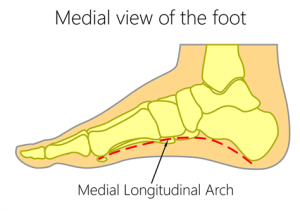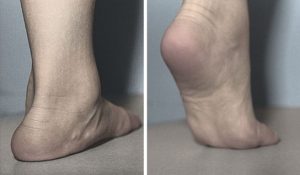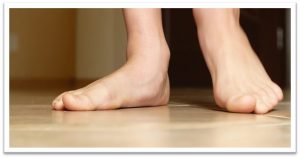Understanding everything you should know about flat feet in Gurgaon, Delhi
Almost every child is born with flat and flexible feet. Once a child is born, they grow exceptionally fast during the first year of their growth period. However, some children might not have fully developed arches until the 3-4 years after they first start walking. Our article aims to inform all parents everything they need to know about flatfeet.
Understanding Foot Development in Children
Every child is born with flat feet because their muscles, bones, and ligaments are yet to develop fully. It is not until your child reaches the age of 3 that you might start noticing the formation of the main arch of the foot; aka medial longitudinal arch.

This arch continues to develop until the age of 10. And in many situations mature arch foot isn’t attained till the age of 7. In layman’s language, it is normal for a child to have flatfeet before a certain age (3-4 years) so parents should not worry too much. Flat foot naturally corrects itself as the child grows, and the muscles start to strengthen. But if it doesn’t then you must consult a pediatric orthopedic doctor.
What happens when flat foot is not corrected?
Children with flat feet in Gurgaon, Delhi are often referred to as ‘Pes Planus’ in medical terms. This means a fallen arch of the foot that comes in full contact with the surface when they stand.
People with flat feet can be further classified into dichotomies of:
- Symptomatic flatfeet exhibits signs such as pain and limitation of activity.
- Asymptomatic flatfeet show no symptoms whatsoever.
One common characteristic between both symptomatic and asymptomatic is the partial or total collapse of the arch. Pediatric flat feet, as mentioned earlier, can be divided into symptomatic and asymptomatic. Understanding this classification can undoubtedly help you and your surgeon understand the best treatment for your child.

seaviewortho.com
Parents are concerned about this deformity, but it is essential to know majority cases of flat feet among kids in Gurgaon, Delhi aren’t problematic and do not require any primary treatment.
Understanding When the Child Requires Treatment
Flatfeet only require a treatment when it is associated with pain or is hindering the child’s ability to perform in daily chores.
Some of the common symptoms for the latter would be:
- Abnormal walking pattern
- Rolling of ankles
- Sore feet after limited activity
- Outward tilting of the heel
- Tenderness of feet accompanied with cramping
- Voluntary withdrawal from physical activities
- Bunion development inside the foot (a deformity of the big toe and joints often caused due to poor foot mechanics)
What causes flat feet?
Many disorders cause flat feet. Some of them are extrinsic and some underlying issues related to health.
Here are some most common conditions that cause flat feet:
- Cerebral palsy
- Juvenile arthritis
- Muscular dystrophy
- Disorders affecting the nervous system
- Obesity
- Early footwear
- Connective tissue disorder
- Injuries and accidents
Vertical Talus and Congenital Oblique Talus
Vertical Talus and Congenital Oblique Talus are two forms of foot deformities that many children are born with and could be a possible reason for flat feet.
- Congenital oblique talus is the less extreme version of Vertical Talus. The talus is a small bone that sits in the ankle and connects the foot with the lower leg. Oblique talus the foot is pointing towards the wrong direction but can be aligned usually whenever it is put down. It looks severe when compared to a usual foot but looks less harsh than a vertical talus foot.
- In vertical talus, the talus points towards the ground; in the wrong direction resulting in stiff foot with no arch also known as ‘rocker-bottom foot’.
Both of these can be treated with surgical and non-surgical methods that have been discussed further in this article.
Types of flat feet
Based on the physical appearance and symptoms, your child could be suffering from either of the following types of flat feet:
1. Flexible
Flexible flat feet is the most common type of flat feet that isn’t associated with any problems or pain.
In this condition, your soles touch the ground completely when you place them on the surface. Here, the arches of the feet can only be seen when you lift your feet off the ground.

In the majority of the cases, flexible flat feet do not require any medical intervention or even support.
However, in some rare cases when medical intervention is called for then the primary focus is laid down on the root cause of the problem and how one cure can it, followed by a secondary emphasis on the flat feet.
2. Rigid
Rigid flat feet is the less occurring type of flat feet that might bring in some complications with it.
The main reason for this is the abnormal development of the foot. It is popularly known as “true flat foot”. Important to mention that rigid feet is not a common phenomenon in children and often occurs in adults only.

If not treated then this type of flat feet end up worsening with time and can cause extreme pain and swelling. In some rare cases, it can even develop into arthritis.
Anyone suffering from true flat feet in Gurgaon, Delhi ultimately might have to get surgery done. One of the most common reasons for rigid flat feet is a tarsal coalition; it is a state in which two or more bones are abnormally connected with each other.
Tarsal coalition can be treated with the help of resection surgery that can help you reduce the pain and preserve normal foot.
Flat Feet Treatment in Gurgaon, Delhi
Flat foot can be treated with the help of both invasive and non-invasive techniques with the former one being used less frequently than the latter.
Non-invasive procedures include:
- Exercise– Physical therapy is considered to be one of the most effective ways to treat flat feet. There are many exercises out there that your doctor can recommend to you. Exercises like heel cord stretching, golf ball roll, arch lifts, and calf raises are the most acclaimed ones.
- Lifestyle changes– In many situations where flat feet are a result of obesity, your doctor would set out a healthy regime for you. Whereas, other cases, you might be asked to wear orthopedic shoes that will provide you with extra cushioning and comfort.
- Understanding insoles– While choosing insoles for flat feet, you must put your comfort first and check if the chosen insole helps you release pain and function naturally. In recent times 3D printed insoles have been creating a lot of buzz in the industry. It is an increasingly popular option for people looking for extra comfort who do not mind paying extra for it. It would be best if you also opted for the low arch with maximum support; a firm arch that is high is likely to be more painful.
- Arch support- While arch support is not uncommon, it cannot treat flat feet but can help you reduce the Arch supports are an orthotic device that is curated, especially to provide support to your feet. These would be curated to provide extra cushioning as per the contours of your feet.
Invasive treatment:
- Surgery is the last resort for anyone suffering from the problem of flat feet in Gurgaon, Delhi. Even though surgery might not be your best option, it will certainly help you and give you a positive outcome. Your orthopedic surgeon depending upon the problem that has caused flat feet, will try to cure it via surgical methods like creating a false arch, repairing the tendons, or fusing the bones or joints in place.
With this, we hope you were able to garner all the information that you were looking for regarding flat foot.




